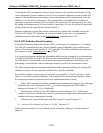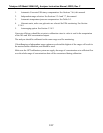
Teledyne API Model 200AU NO
X
Analyzer Instruction Manual, 02293, Rev. F
7-11
Table 7-10: Activity Matrix for Calibration Procedure
Equipment/
Supplies
Acceptance Limits
Frequency And Method
Of Measurement
Action If Requirements
Are Not Met
Calibration
gases
Sec. 2.0.7, Subsec. 7.1
(Q.A. Handbook)
Assayed against an
NIST-SRM quarterly,
Sec. 2.0.7, (Q.A.
Handbook)
Working gas standard is
unstable, and/or
measurement method is
out of control; take
corrective action such as
obtaining new calibration
gas.
Dilution gas Zero air, free of
contaminants; TAD
2
and
Sec. 2.0.7, Subsec. 7.1
(Q.A. Handbook)
See TAD
2
Return to supplier or take
appropriate action with
generation system
Multi-point
calibration
(GPT)
1. t
R
< 2 minutes P
R
>
2.75 ppm/min
2. Use calibration
procedure in
Subsection 2.4 (Q.A.
Handbook); also TAD
2
and Federal Register
3. Converter efficiency >
96%
Method
1. Sect. 7.6.4 (this
manual)
2. Section 7.6.5.3 (this
manual), TAD
2
,
Federal Register
and
Figure 7-2; see
Section 7.6.7 for
frequency
3. Subsection 7.6.6 (this
manual)
1. Adjust flow conditions
and/or reaction chamber
volume to meet
suggested limits
2. Repeat the calibration
3. Replace or service the
converter
7.6.2 Calibration Gas and Zero Air Sources
Production of Zero Air
Due to the high sensitivity of the M200AU special care must be taken to assure that the zero air
has extremely low levels of pollutants. We recommend using Ultra Zero Air, which is commonly
used for gas chromatographic applications. If other zero air sources are used, the NO
concentration should be < 1 ppt (0.001 ppb) and the concentration of interferent gasses should be
< 1 ppt (0.001 ppb) for the sum total of all interferents.
Devices that condition ambient air by drying and removal of pollutants are available on the
commercial market such as the Teledyne API Model 701 Zero Air Module. We recommend this
type of device for generating zero air. Detailed procedures for generating zero air are in TAD
2
.


















